Презентация What is Game-Based Learning GBL 1

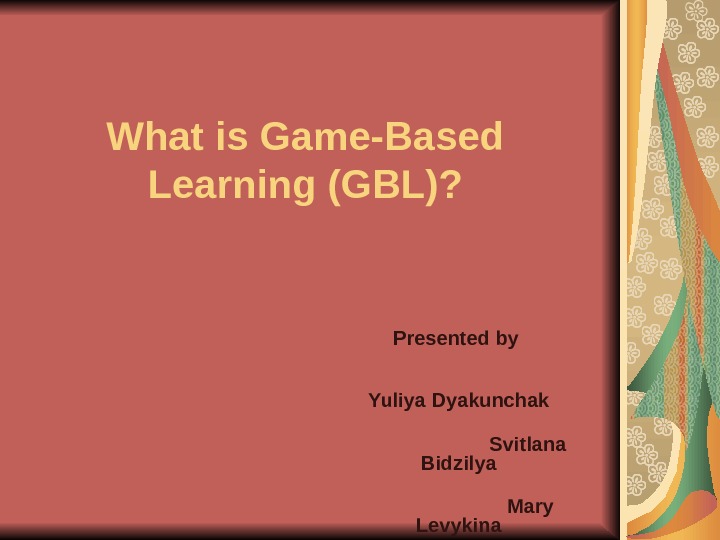

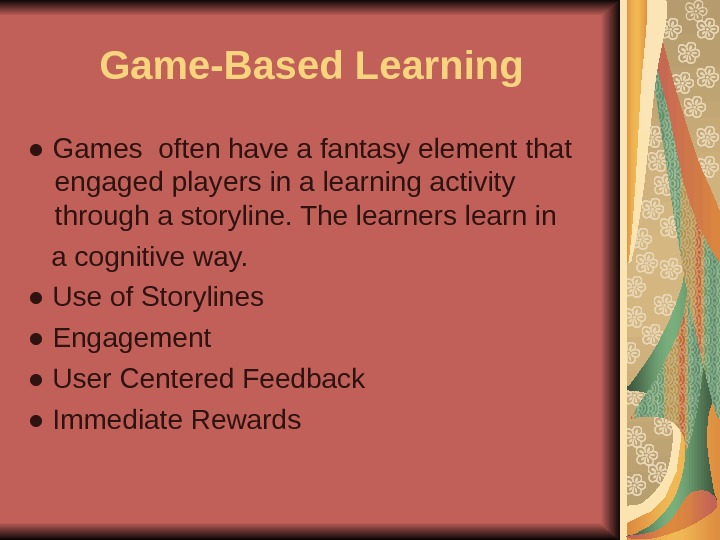
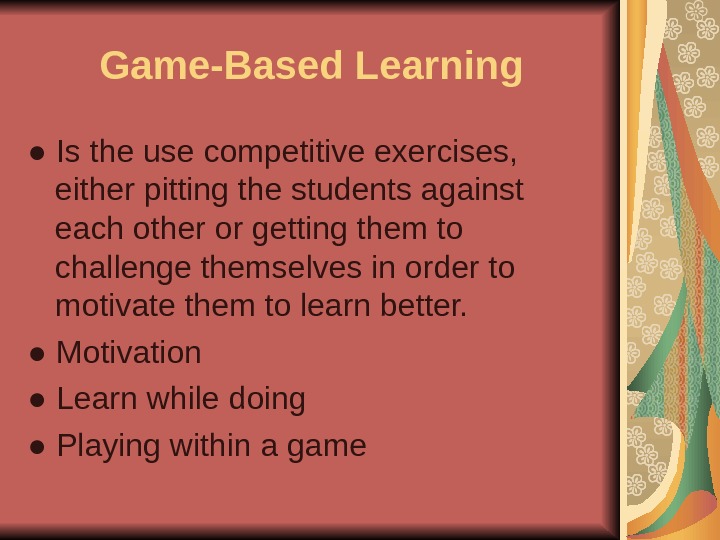
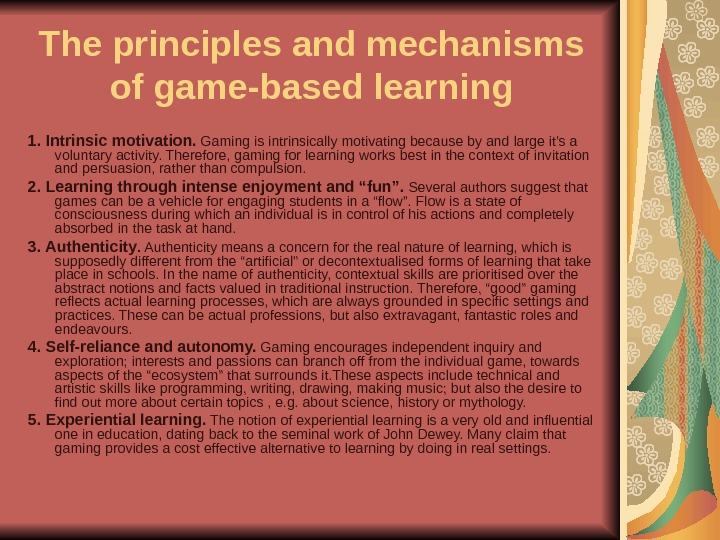

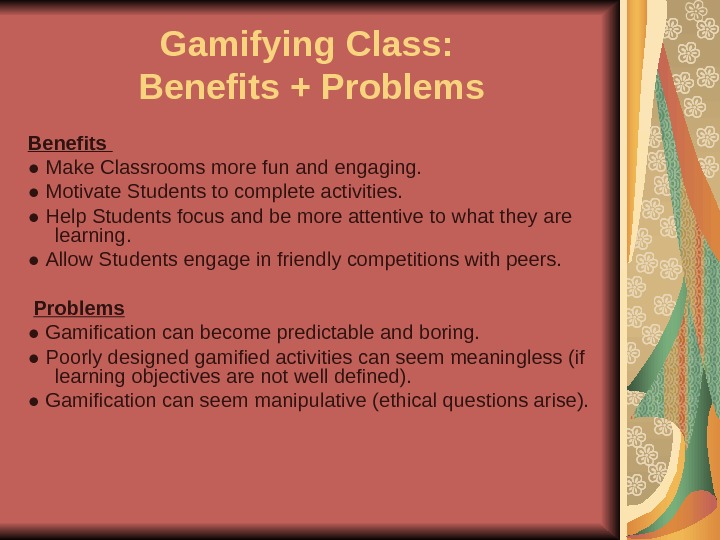
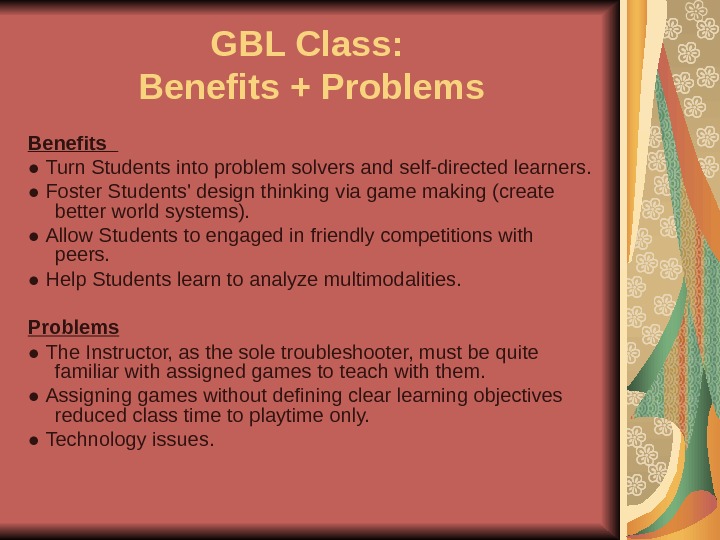

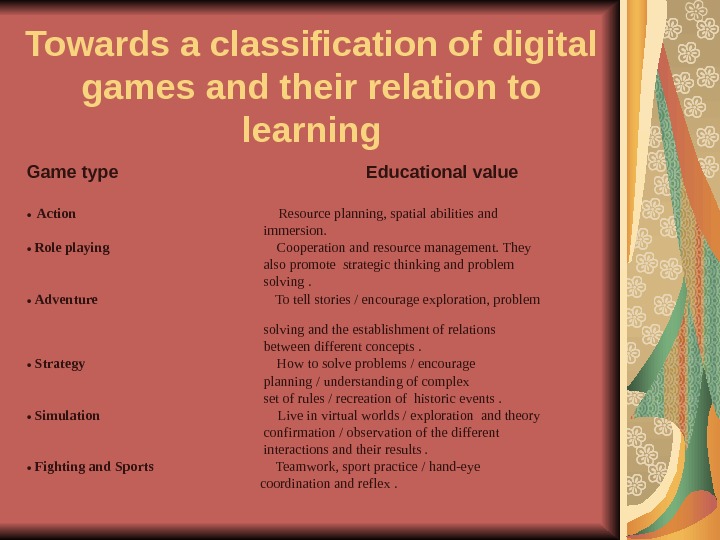

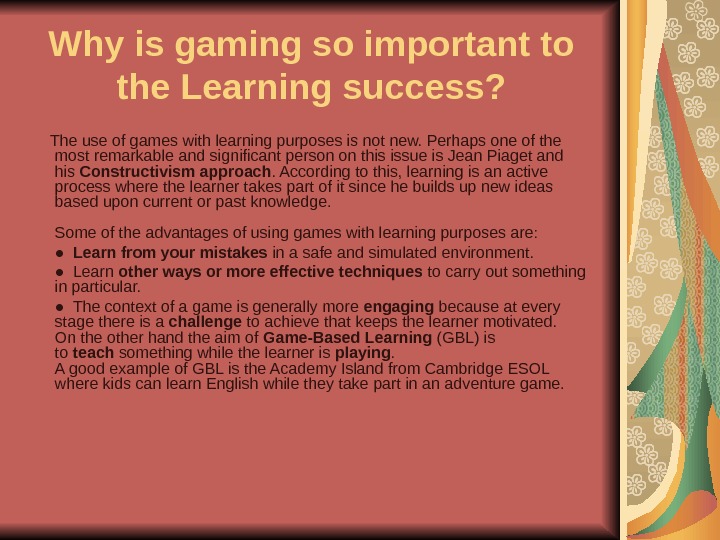
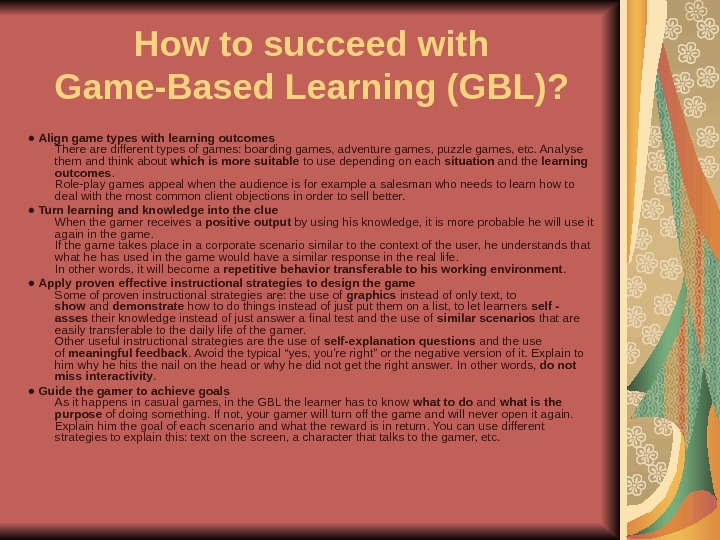

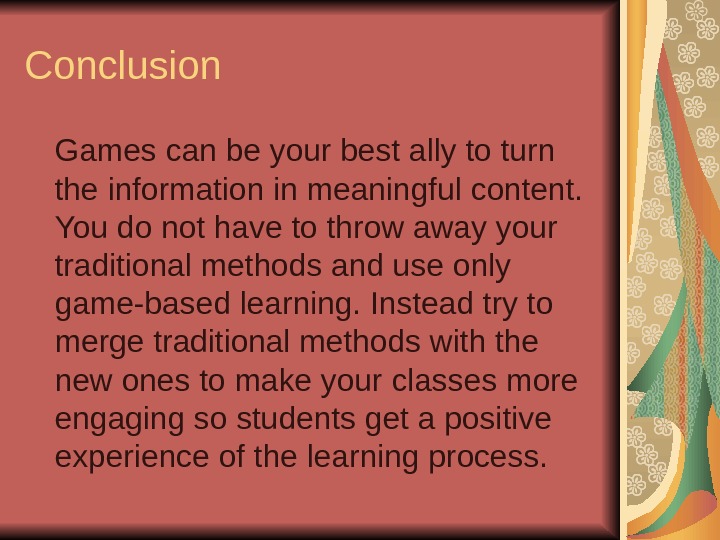
- Размер: 156 Кб
- Количество слайдов: 15
Описание презентации Презентация What is Game-Based Learning GBL 1 по слайдам
 What is Game-Based Learning (GBL)? Presented by Yuliya Dyakunchak Svitlana Bidzilya Mary Levykin a
What is Game-Based Learning (GBL)? Presented by Yuliya Dyakunchak Svitlana Bidzilya Mary Levykin a
 Theory: What is Game- Based Learning (GBL)? » Game-based learning (GBL) is a type of game play that has defined learning outcomes. Generally, game-based learning is designed to balance subject matter with game play and the ability of the player to retain and apply said subject matter to the real world». In other words, game-based learning is the use of games (analog or digital) for teaching a subject matter. The idea is to get students to play with already made games to fulfill a learning objective.
Theory: What is Game- Based Learning (GBL)? » Game-based learning (GBL) is a type of game play that has defined learning outcomes. Generally, game-based learning is designed to balance subject matter with game play and the ability of the player to retain and apply said subject matter to the real world». In other words, game-based learning is the use of games (analog or digital) for teaching a subject matter. The idea is to get students to play with already made games to fulfill a learning objective.
 Game-Based Learning ● Games often have a fantasy element that engaged players in a learning activity through a storyline. The learners learn in a cognitive way. ● Use of Storylines ● Engagement ● User Centered Feedback ● Immediate Rewards
Game-Based Learning ● Games often have a fantasy element that engaged players in a learning activity through a storyline. The learners learn in a cognitive way. ● Use of Storylines ● Engagement ● User Centered Feedback ● Immediate Rewards
 Game-Based Learning ● Is the use competitive exercises, either pitting the students against each other or getting them to challenge themselves in order to motivate them to learn better. ● Motivation ● Learn while doing ● Playing within a game
Game-Based Learning ● Is the use competitive exercises, either pitting the students against each other or getting them to challenge themselves in order to motivate them to learn better. ● Motivation ● Learn while doing ● Playing within a game
 The principles and mechanisms of game-based learning 1. Intrinsic motivation. Gaming is intrinsically motivating because by and large it’s a voluntary activity. Therefore, gaming for learning works best in the context of invitation and persuasion, rather than compulsion. 2. Learning through intense enjoyment and “fun”. Several authors suggest that games can be a vehicle for engaging students in a “flow”. Flow is a state of consciousness during which an individual is in control of his actions and completely absorbed in the task at hand. 3. Authenticity means a concern for the real nature of learning, which is supposedly different from the “artificial” or decontextualised forms of learning that take place in schools. In the name of authenticity, contextual skills are prioritised over the abstract notions and facts valued in traditional instruction. Therefore, “good” gaming reflects actual learning processes, which are always grounded in specific settings and practices. These can be actual professions, but also extravagant, fantastic roles and endeavours. 4. Self-reliance and autonomy. Gaming encourages independent inquiry and exploration; interests and passions can branch off from the individual game, towards aspects of the “ecosystem” that surrounds it. These aspects include technical and artistic skills like programming, writing, drawing, making music; but also the desire to find out more about certain topics , e. g. about science, history or mythology. 5. Experiential learning. The notion of experiential learning is a very old and influential one in education, dating back to the seminal work of John Dewey. Many claim that gaming provides a cost effective alternative to learning by doing in real settings.
The principles and mechanisms of game-based learning 1. Intrinsic motivation. Gaming is intrinsically motivating because by and large it’s a voluntary activity. Therefore, gaming for learning works best in the context of invitation and persuasion, rather than compulsion. 2. Learning through intense enjoyment and “fun”. Several authors suggest that games can be a vehicle for engaging students in a “flow”. Flow is a state of consciousness during which an individual is in control of his actions and completely absorbed in the task at hand. 3. Authenticity means a concern for the real nature of learning, which is supposedly different from the “artificial” or decontextualised forms of learning that take place in schools. In the name of authenticity, contextual skills are prioritised over the abstract notions and facts valued in traditional instruction. Therefore, “good” gaming reflects actual learning processes, which are always grounded in specific settings and practices. These can be actual professions, but also extravagant, fantastic roles and endeavours. 4. Self-reliance and autonomy. Gaming encourages independent inquiry and exploration; interests and passions can branch off from the individual game, towards aspects of the “ecosystem” that surrounds it. These aspects include technical and artistic skills like programming, writing, drawing, making music; but also the desire to find out more about certain topics , e. g. about science, history or mythology. 5. Experiential learning. The notion of experiential learning is a very old and influential one in education, dating back to the seminal work of John Dewey. Many claim that gaming provides a cost effective alternative to learning by doing in real settings.
 G amification and GBL ● Gamification = Turn the world into a playable and meaningful game in order to achieve specific objectives. ● Game- Based Learning (GBL) = Apply concepts to interpreting the meaning of existing game worlds. Or, reframe the game worlds as a »playground» for experimentation and analysis of concepts. Which One? : It all depends on your teaching objectives! Want to modify students behavior ? Gamify! Want to »reframe» the world for students to experiment or test concepts? Use GBL! Choose the method that best fits your teaching objectives!
G amification and GBL ● Gamification = Turn the world into a playable and meaningful game in order to achieve specific objectives. ● Game- Based Learning (GBL) = Apply concepts to interpreting the meaning of existing game worlds. Or, reframe the game worlds as a »playground» for experimentation and analysis of concepts. Which One? : It all depends on your teaching objectives! Want to modify students behavior ? Gamify! Want to »reframe» the world for students to experiment or test concepts? Use GBL! Choose the method that best fits your teaching objectives!
 Gamifying Class: Benefits + Problems Benefits ● Make Classrooms more fun and engaging. ● Motivate Students to complete activities. ● Help Students focus and be more attentive to what they are learning. ● Allow Students engage in friendly competitions with peers. Problems ● Gamification can become predictable and boring. ● Poorly designed gamified activities can seem meaningless (if learning objectives are not well defined). ● Gamification can seem manipulative (ethical questions arise).
Gamifying Class: Benefits + Problems Benefits ● Make Classrooms more fun and engaging. ● Motivate Students to complete activities. ● Help Students focus and be more attentive to what they are learning. ● Allow Students engage in friendly competitions with peers. Problems ● Gamification can become predictable and boring. ● Poorly designed gamified activities can seem meaningless (if learning objectives are not well defined). ● Gamification can seem manipulative (ethical questions arise).
 GBL Class: Benefits + Problems Benefits ● Turn Students into problem solvers and self-directed learners. ● Foster Students’ design thinking via game making (create better world systems). ● Allow Students to engaged in friendly competitions with peers. ● Help Students learn to analyze multimodalities. Problems ● The Instructor, as the sole troubleshooter, must be quite familiar with assigned games to teach with them. ● Assigning games without defining clearning objectives reduced class time to playtime only. ● Technology issues.
GBL Class: Benefits + Problems Benefits ● Turn Students into problem solvers and self-directed learners. ● Foster Students’ design thinking via game making (create better world systems). ● Allow Students to engaged in friendly competitions with peers. ● Help Students learn to analyze multimodalities. Problems ● The Instructor, as the sole troubleshooter, must be quite familiar with assigned games to teach with them. ● Assigning games without defining clearning objectives reduced class time to playtime only. ● Technology issues.
 What are the characteristics of a gamified classroom? ● Instead of starting with an »A» and trying to keep it, everyone begins at 0 and »levels up» to an »A» ● Quest based ● As quests are completed new quest are opened and quests get progressively harder. You may not advance until you have mastered the skill in the quest. ● 3 d Game. Lab ● Using the Education Gamification group in Edmodo
What are the characteristics of a gamified classroom? ● Instead of starting with an »A» and trying to keep it, everyone begins at 0 and »levels up» to an »A» ● Quest based ● As quests are completed new quest are opened and quests get progressively harder. You may not advance until you have mastered the skill in the quest. ● 3 d Game. Lab ● Using the Education Gamification group in Edmodo
 Towards a classification of digital games and their relation to learning Game type Educational value ● Action Resource planning, spatial abilities and immersion. ● Role playing Cooperation and resource management. They also promote strategic thinking and problem solving. ● Adventure To tell stories / encourage exploration, problem solving and the establishment of relations between different concepts. ● Strategy How to solve problems / encourage planning / understanding of complex set of rules / recreation of historic events. ● Simulation Live in virtual worlds / exploration and theory confirmation / observation of the different interactions and their results. ● Fighting and Sports Teamwork, sport practice / hand-eye coordination and reflex.
Towards a classification of digital games and their relation to learning Game type Educational value ● Action Resource planning, spatial abilities and immersion. ● Role playing Cooperation and resource management. They also promote strategic thinking and problem solving. ● Adventure To tell stories / encourage exploration, problem solving and the establishment of relations between different concepts. ● Strategy How to solve problems / encourage planning / understanding of complex set of rules / recreation of historic events. ● Simulation Live in virtual worlds / exploration and theory confirmation / observation of the different interactions and their results. ● Fighting and Sports Teamwork, sport practice / hand-eye coordination and reflex.
 Game Mechanics ● Cascading Information Theory ● Achievements ● Blissful productivity ● Community of Collaboration (Affinity Group) ● Urgent Optimism and Epic Meaning ● Quests ● Points or XP ● Levels or Leveling Up
Game Mechanics ● Cascading Information Theory ● Achievements ● Blissful productivity ● Community of Collaboration (Affinity Group) ● Urgent Optimism and Epic Meaning ● Quests ● Points or XP ● Levels or Leveling Up
 Why is gaming so important to the Learning success? The use of games with learning purposes is not new. Perhaps one of the most remarkable and significant person on this issue is Jean Piaget and his Constructivism approach. According to this, learning is an active process where the learner takes part of it since he builds up new ideas based upon current or past knowledge. Some of the advantages of using games with learning purposes are: ● Learn from your mistakes in a safe and simulated environment. ● Learn other ways or more effective techniques to carry out something in particular. ● The context of a game is generally more engaging because at every stage there is a challenge to achieve that keeps the learner motivated. On the other hand the aim of Game-Based Learning (GBL) is to teach something while the learner is playing. A good example of GBL is the Academy Island from Cambridge ESOL where kids can learn English while they take part in an adventure game.
Why is gaming so important to the Learning success? The use of games with learning purposes is not new. Perhaps one of the most remarkable and significant person on this issue is Jean Piaget and his Constructivism approach. According to this, learning is an active process where the learner takes part of it since he builds up new ideas based upon current or past knowledge. Some of the advantages of using games with learning purposes are: ● Learn from your mistakes in a safe and simulated environment. ● Learn other ways or more effective techniques to carry out something in particular. ● The context of a game is generally more engaging because at every stage there is a challenge to achieve that keeps the learner motivated. On the other hand the aim of Game-Based Learning (GBL) is to teach something while the learner is playing. A good example of GBL is the Academy Island from Cambridge ESOL where kids can learn English while they take part in an adventure game.
 How to succeed with Game-Based Learning (GBL) ? ● Align game types with learning outcomes There are different types of games: boarding games, adventure games, puzzle games, etc. Anal y se them and think about which is more suitable to use depending on each situation and the learning outcomes. Role-play games appeal when the audience is for example a salesman who needs to learn how to deal with the most common client objections in order to sell better. ● Turn learning and knowledge into the clue When the gamer receives a positive output by using his knowledge, it is more probable he will use it again in the game. If the game takes place in a corporate scenario similar to the context of the user, he understands that what he has used in the game would have a similar response in the real life. In other words, it will become a repetitive behavior transferable to his working environment. ● Apply proven effective instructional strategies to design the game Some of proven instructional strategies are: the use of graphics instead of only text, to show and demonstrate how to do things instead of just put them on a list, to let learners self — asses their knowledge instead of just answer a final test and the use of similar scenarios that are easily transferable to the daily life of the gamer. Other useful instructional strategies are the use of self-explanation questions and the use of meaningful feedback. Avoid the typical “yes, you’re right” or the negative version of it. Explain to him why he hits the nail on the head or why he did not get the right answer. In other words, do not miss interactivity. ● Guide the gamer to achieve goals As it happens in casual games, in the GBL the learner has to know what to do and what is the purpose of doing something. If not, your gamer will turn off the game and will never open it again. Explain him the goal of each scenario and what the reward is in return. You can use different strategies to explain this: text on the screen, a character that talks to the gamer, etc.
How to succeed with Game-Based Learning (GBL) ? ● Align game types with learning outcomes There are different types of games: boarding games, adventure games, puzzle games, etc. Anal y se them and think about which is more suitable to use depending on each situation and the learning outcomes. Role-play games appeal when the audience is for example a salesman who needs to learn how to deal with the most common client objections in order to sell better. ● Turn learning and knowledge into the clue When the gamer receives a positive output by using his knowledge, it is more probable he will use it again in the game. If the game takes place in a corporate scenario similar to the context of the user, he understands that what he has used in the game would have a similar response in the real life. In other words, it will become a repetitive behavior transferable to his working environment. ● Apply proven effective instructional strategies to design the game Some of proven instructional strategies are: the use of graphics instead of only text, to show and demonstrate how to do things instead of just put them on a list, to let learners self — asses their knowledge instead of just answer a final test and the use of similar scenarios that are easily transferable to the daily life of the gamer. Other useful instructional strategies are the use of self-explanation questions and the use of meaningful feedback. Avoid the typical “yes, you’re right” or the negative version of it. Explain to him why he hits the nail on the head or why he did not get the right answer. In other words, do not miss interactivity. ● Guide the gamer to achieve goals As it happens in casual games, in the GBL the learner has to know what to do and what is the purpose of doing something. If not, your gamer will turn off the game and will never open it again. Explain him the goal of each scenario and what the reward is in return. You can use different strategies to explain this: text on the screen, a character that talks to the gamer, etc.
 How to succeed with Game-Based Learning (GBL) ? ● The game must be immersive Take care of the storyline , the background of the game is important. It has to be coherent , especially if the scenario tries to simulate a working environment. If you want them to transfer the knowledge acquired, the scenarios must be similar to the ones in the real life. Moreover, if you let the gamer be part of the storyline instead of being only who controls the character you will get better results. To sum up, let the learner be part of the game. ● It must be challenging Neither so easy nor extremely difficult. The key is to increase the difficulty while playing. At the beginning of the game, the gamer needs to get used to the game, but after this previous stage, he wants challenges to carry on playing. If the gamer does not face up challenges he will not be engage and you will lose the learner and so your learning outcomes. ● The game must be reliable If the audience of your game are employees they expect to obtain knowledge, skills and abilities in order to do their job better. In other words, the most important thing is to focus on the learning outcomes. As in the example above, the game expects an environment to practice his sales strategy, to see the response of the client and to learn other effective abilities for him to sell better.
How to succeed with Game-Based Learning (GBL) ? ● The game must be immersive Take care of the storyline , the background of the game is important. It has to be coherent , especially if the scenario tries to simulate a working environment. If you want them to transfer the knowledge acquired, the scenarios must be similar to the ones in the real life. Moreover, if you let the gamer be part of the storyline instead of being only who controls the character you will get better results. To sum up, let the learner be part of the game. ● It must be challenging Neither so easy nor extremely difficult. The key is to increase the difficulty while playing. At the beginning of the game, the gamer needs to get used to the game, but after this previous stage, he wants challenges to carry on playing. If the gamer does not face up challenges he will not be engage and you will lose the learner and so your learning outcomes. ● The game must be reliable If the audience of your game are employees they expect to obtain knowledge, skills and abilities in order to do their job better. In other words, the most important thing is to focus on the learning outcomes. As in the example above, the game expects an environment to practice his sales strategy, to see the response of the client and to learn other effective abilities for him to sell better.
 Conclusion Games can be your best ally to turn the information in meaningful content. You do not have to throw away your traditional methods and use only game-based learning. Instead try to merge traditional methods with the new ones to make your classes more engaging so students get a positive experience of the learning process.
Conclusion Games can be your best ally to turn the information in meaningful content. You do not have to throw away your traditional methods and use only game-based learning. Instead try to merge traditional methods with the new ones to make your classes more engaging so students get a positive experience of the learning process.

